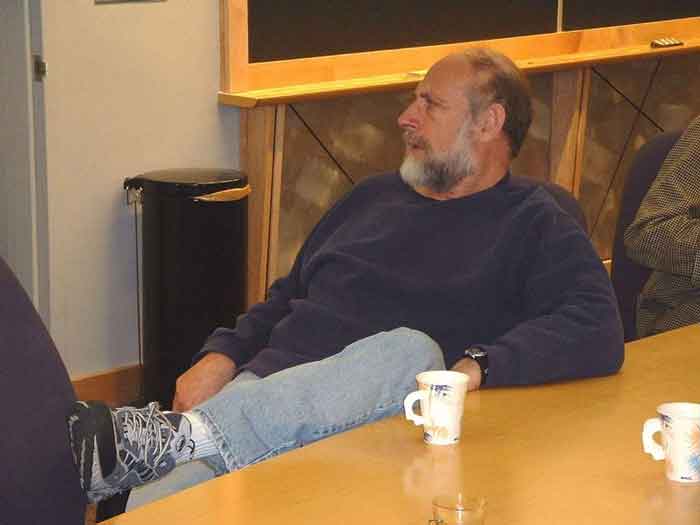.
Leonard Susskind

Leonard Susskind at Stanford Universi (*)
Leonard Susskind (born 1940[1]) is the Felix Bloch professor of theoretical physics at Stanford University in the field of string theory and quantum field theory. Susskind is widely regarded as one of the fathers of string theory for his early contributions to the String Theory model of particle physics.[3]
Background
Susskind was born in New York City and now resides in Palo Alto, California. He began working as a plumber at the age of thirteen. Later, he enrolled in the City College of New York as an engineering student. He has been married twice, originally in 1960,[4] and has four children. Josh Susskind, Doctoral student in Psychology; Jenny Susskind, Recent graduate in Urban Planning, with a special interest in housing rights; Dr. Lana Susskind-Wilder Clinical Neuropsychologist; and Yve Susskind,Ph.D., advocate of youth empowerment. Susskind successfully graduated with a B.S. in Physics in 1962.[4] He then went on to get his Ph.D. in 1965 from Cornell University under Peter A. Carruthers.
Career
Susskind has been Felix Bloch Professor of Physics at Stanford University since 1979. He has been elected to the National Academy of Sciences and the American Academy of Arts and Sciences, and was awarded the 1998 Sakurai Prize for theoretical physics. He is also a distinguished professor at Korea Institute for Advanced Study.[5]
Susskind is the author of two popular science books, The Cosmic Landscape: String Theory and the Illusion of Intelligent Design[6] published in 2005, and THE BLACK HOLE WAR: My battle with Stephen Hawking to make the world safe for quantum mechanics[7] that is currently in press but can be pre-ordered on various websites.
He was one of at least three physicists who independently discovered during or around 1970 that the Veneziano dual resonance model of strong interactions could be described by a quantum mechanical model of strings. [8]
An entire course on quantum physics by Susskind can be downloaded on the iTunes platform from "Stanford on iTunes".[5]
Contributions
Susskind has also made contributions in the following areas of physics:
* The independent discovery of the string theory model of particle physics.
* The theory of quark confinement[9]
* The development of Hamiltonian lattice gauge theory[10]
* The theory of scaling violations in deep inelastic electroproduction
* The theory of symmetry breaking sometimes known as "technicolor theory"[11]
* The second, yet independent, theory of cosmological baryogenesis.[12] (Sakharov's work was first, but was mostly unknown in the Western hemisphere.)
* String theory of black hole entropy[13]
* The principle of "black hole complementarity"[14]
* The holographic principle[15]
* M-theory[16]
* Introduction of holographic entropy bounds in physical cosmology
* The idea of an anthropic string theory landscape[17].
See also
* Superstring theory
* String theory
* QCD
* M-theory
* Supersymmetry
* Quantum field theory
* Holographic principle
Links
* Stanford University Homepage
* The Edge:
o "Interview with Leonard Susskind."
o Susskind and Lee Smolin debate the Anthropic Principle.
* Radio Interview from This Week in Science March 14, 2006 Broadcast
* "Father of String Theory Muses on the Megaverse": Podcast.
* Leonard Susskind's page on the Internet Movie Database.
* Witten was mentioned in the comic Ex Machina.
References
1. ^ a b His 60th birthday was celebrated with a special symposium at Stanford University on May 20-21, 2000.[1]
2. ^ Life in a landscape of possibilities[2]
3. ^ NYAS Publication A Walk Across the Landscape
4. ^ a b Edge.org Leonard Susskind - A Biography (last accessed August 12, 2007).
5. ^ Welcome To Kias
6. ^ L. Susskind, The cosmic landscape: string theory and the illusion of intelligent design (Little, Brown, 2005).
7. ^ L. Susskind, THE BLACK HOLE WAR: My battle with Stephen Hawking to make the world safe for quantum mechanics (Little, Brown, 2008)
8. ^ String Theory: The Early Years, John H. Schwarz, 2000
9. ^ L. Susskind, Lattice Models Of Quark Confinement At High Temperature, Phys. Rev. D20 (1979) 2610.
10. ^ J. Kogut and L. Susskind, Phys. Rev. D 11, 395 (1975).
11. ^ Review of Particle Physics, (W.-M. Yao et al., J. Phys. G 33, 1 (2006)) Dynamical Electroweak Symmetry Breaking section cites two 1979 publications, one by Steven Weinberg, the other by L. Susskind to represent the earliest models with technicolor and technifermions.[3]
12. ^ Biography at APS J. J. Sakurai Prize website (last accessed August 12, 2007).
13. ^ L. Susskind, RU-93-44, hep-th/9309145.
14. ^ L. Susskind, Phys. Rev. Lett. 71, 2368 (1993). String theory and the principle of black hole complementarity.
15. ^ "The insistence on unitarity in the presence of black holes led 't Hooft (1993) and Susskind (1995b) to embrace a more radical, holographic interpretation of ..." - The Holographic Principle, Raphael Bousso, Rev. Mod. Phys. 74 (2002) 825-874. [4]
16. ^ T. Banks, W. Fischler, S. H. Shenker, and L. Susskind, M Theory as a Matrix Model: A Conjecture, Phys. Rev. D55 (1997) 5112–5128, hep-th/9610043.
17. ^ L. Susskind, arXiv:hep-th/0302219.
Retrieved from "http://en.wikipedia.org/"
All text is available under the terms of the GNU Free Documentation License

